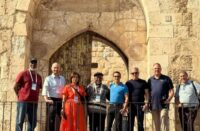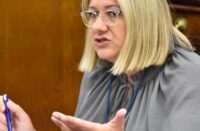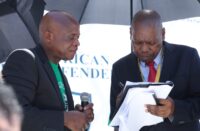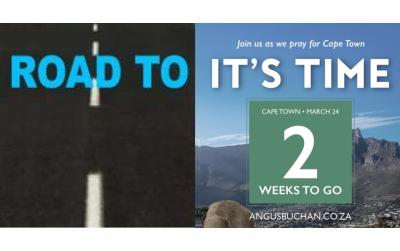
Ashley Cloete continues with his spiritual history of the Cape which he believes is building to a climax, of which the It’s Time Cape Town prayer day on March 24 will be a part.
Episode 3: Cape churchmen divinely used in global connections
Last week we noted how Magdalena, one of the five converts whom Georg Schmidt had baptised, became a revival trailblazer. Another one of his converts would be God’s special instrument, a catalyst to influence Church history significantly. At the deathbed of this convert Dr Helperus Ritzema van Lier, the new evangelical young minister of the Groote Kerk, was deeply moved. Van Lier would be divinely used to influence the history of missions in Europe significantly.
Islam blossomed in Mother City
Slaves felt unwelcome at the first two Cape churches until the Zuid-Afrikaanse Gesticht congregation in Long Street was established by the South African Missionary Society. The saying had gone around in slave circles that “de zwarte kerk is de slamse kerk’” implying that the mosque was the right place of worship for the slaves. Cape Christian colonists were encouraging their slaves to become Muslims so that they could still be sold like cattle. That was the period of Cape history when Islam blossomed in the Mother City of South Africa.
GROUND ZERO PRAYER STRATEGY
Jericho Walls International Prayer Network invites the whole of South Africa to join hands with Cape Town over 40 days as they prepare physically and spiritually for the very significant It’s Time prayer event — to cry out to God for Cape Town and the nation
Holy Spirit preparation The three Genadendal missionaries who arrived in 1792 – –Christian Kühnel, Hendrik Marsveld and Daniel Schwinn — recorded the instance of a man who dreamed that three men would come to teach them.
“They (the Khoi) say that they spoke about it often because they very much wished for it to happen.”
In the diaries of these three missionaries one reads again and again of Khoi coming to them, wanting to accept the Lord into their lives and wishing to be baptised. Evidently the Holy Spirit had prepared these people. On a daily basis the Genadendal missionaries were overwhelmed by questions such as ‘What must I do to be saved?’ It is striking that those who came to faith in Christ also sought protection against satanic forces.
International impact of Van Lier
Van Lier was a world Christian. Almost single-handedly the young preacher set the evangelical world ablaze. His letters from the Cape to Europe were very influential indeed. He wrote his testimony as six letters to Rev John Newton in England. The influence and power of divine grace in his life made a lasting impression on John Newton, who belonged to the inner circle of (slave) abolitionists. The famous hymn Amazing Grace came from Newton’s pen.
Various Van Lier letters had the goal of getting the Moravians back to the Cape. His correspondence continued to have an impact in Europe. Through his evangelical zeal Van Lier, along with William Carey’s book An enquiry into the obligations of Christians to use means for the conversion of the heathens, definitely laid the foundation for a missionary society at the Cape.
What a joy it was for Van Lier to welcome the three Moravian missionaries to his table after returning from sick leave. However, his days were numbered. He became critically ill not long thereafter. Tragically, Van Lier was not around to see the actual founding of the South African Mission Society (SAMS) in April 1799 at the Zuid-Afrikaanse Gesticht. He had died of tuberculosis in March 1793 at the age of only 28.
A special legacy of the mission-minded minister of the Groote Kerk was the idea of three forays of missionary endeavour — to the Xhosas of the Eastern Cape, to the San of the Northern Cape, and in the town and surrounds.
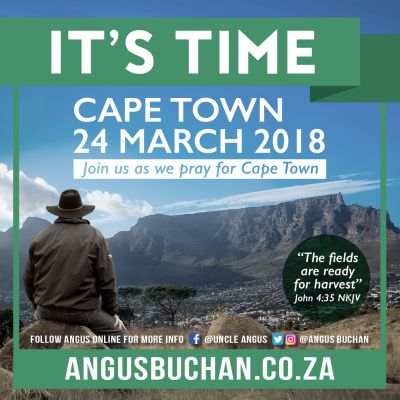
[fbvideo link=”https://www.facebook.com/UncleAngus/videos/10156324068573856/” width=”400″ height=”380″ onlyvideo=”1″]
Divine overruling
How pervasive the ownership of slaves was, is illustrated by Reverend Michiel Vos, a very influential Cape compatriot of Van Lier. He taught his intelligent slave, Maart, who hailed from Mozambique, so well that the London Missionary Society (LMS) contemplated using him as a missionary in his native country. But Vos did not baptise him.
The clear support of Dr Johannes van der Kemp and Dr John Philip, his successor as Cape leader of the LMS, for the slaves and the indigenous Khoisan, caused intense resentment towards all missionaries. Whereas the earthquake of December 11809 at the Cape was quite clearly divine stuff that countered the moral decay at the Cape.
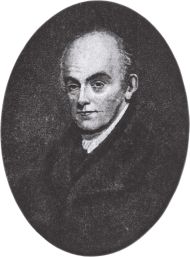
The opposition of William Wilberforce to the slave trade and slavery in general in the British parliament stimulated and encouraged Dr Philip, (LMS). Conversely, Philip’s volumes of Researches in South Africa assisted Wilberforce and Thomas Clarkson to get the final legislation passed which ultimately outlawed slavery in the entire British Empire.
The run-up to the emancipation of the slaves were among the main causes of the Great Trek into the interior. Piet Retief, a Voortrekker leader, stressed this in his published manifesto. A less known woman highlighted the fact that the missionaries put people of colour on an equal footing with them as an important grievance.
A trail for a better understanding
Van der Kemp blazed a trail for a better understanding between the Dutch Reformed Church and the missionaries when he stuck to his calling to the indigenous peoples, refusing to become the pastor of Graaff-Reinet. In a compromise, his colleague Aart Athonij van der Lingen, who had been refused permission by Dutch governor De Mist to work among the slaves at the Cape, became the Graaff-Reinet pastor.
Hereafter various missionaries sent out by the London and Rotterdam missionary societies ended their days as pastors of Dutch Reformed congregations, blessing that denomination with an evangelical stamp of commitment to the word of God. At the same time the negative vibes of the colonists towards the missionaries from abroad decreased. Many a country town was named after some missionary.
Another divine element to prepare the revival was ironically the attempt by governor Lord Charles Somerset to anglicise the Cape. English speakers heaped scorn on locally-spoken Dutch. Afrikaners themselves were hereafter inclined to use derogatory terms to describe their vernacular.
Ds Gottlieb van der Lingen, the son of a London Missionary Society (LMS) missionary pioneer, opposed the anglicizing of Cape society. God divinely overruled Van der Lingen’s bigoted and nationalistic vision. Instead of safeguarding the culture of the elite, two of the recruited Dutch teachers, Arnoldus Pannevis and Cornelis P Hoogenhout, became staunch fighters to get the Bible translated into the vernacular of the poor, the “kombuistaal” of inferior Dutch. That would become the language Afrikaans that ultimately replaced Dutch as one of the two official languages of the country.
The advent of Tuan Guru
In the spiritual realm the enemy of souls responded to the mini revival that followed the Van Lier’s stint at the Cape with the advent of an Islamic giant. Tuan Guru, meaning mister teacher, was brought to Robben Island as a state prisoner in 1780 from Tidore, which was a flourishing Muslim sultanate. He became one of the prominent Muslim leaders at the Cape when he was set free in 1793.
Tuan Guru had a thorough understanding of Islam, in contrast to other Capetonians who hailed from Indonesia. One of his first accomplishments was the writing of the Qur’an from memory for the use of the Cape Muslims. In 1781 Tuan Guru also wrote M’arifatul Islami wal Imani (Manifestations of Islam and faith), an Islamic manual for day-to-day living, while he was imprisoned on Robben Island.
Reverend Michiel Vos was a child of his time in respect of the ownership of slaves. So was Tuan Guru. He had a few slaves but they did not provide a secure income for his children. The Muslim historian Achmat Davids blasted the popular notion that imams bought slaves merely to set them free. Just like the colonists, they purchased slaves “for security and as a means of investment”. Davids pointed out that Tuan Guru found it necessary in 1806 to purchase a fisherman slave “to improve his property value”.
At the same time Tuan Guru established Islam at the Cape firmly as the founder of the first mosque of South Africa in Dorp Street, Bo-Kaap.
Increase in missionary zeal
Two local ministers of early Cape churches networked closely. The Presbyterian Dr James Adamson and Rev Georg Wilhelm Stegmann engaged in combined evangelistic endeavours. Soon after his ordination as a Lutheran minister, Stegmann felt the need to do something for slaves.
The emancipation of slaves was a significant catalyst towards a mini revival at the Cape. The organised mission to the slaves started on December 1 1838 — the date of the official emancipation. Many a Cape Muslim came to faith in Jesus at that time.
Missionary diamonds formed
Van der Kemp, leader of the first four London Missionary Society (LMS) pioneers, led the outreach to the Eastern Cape. Strongly influenced by the French philosopher Jean Jacques Rousseau, he became a forceful fighter for human rights of all people of colour. In no time he mastered the difficult Xhosa language, ministering to the Ngika (Gaika) tribe. From that tribe missionary diamonds came from the rocky soil of oppressive colonial history.
In the wake of the war on the eastern frontier of the Cape Colony, a group of Xhosa-speakers from the Eastern Cape became inhabitants of Genadendal during this period. A Gaika woman, whose husband had deserted her, was such a missionary “diamond”. She was among the first “Blacks” to be settled in Genadendal. There this woman, who later got the name Wilhelmina, became a follower of Jesus.
In Genadendal the missionary spirit took hold of Wilhelmina. Soon she urged the Genadendal Moravians to start independent work among her own people. She was appointed as nursemaid to the children of the missionaries. She also assisted with the teaching of the little ones at the “kindergarten” of Genadendal, setting out to teach the missionaries’ children the fundamentals of Xhosa, so that they could bring the gospel to her people. Johann Adolph, the son of Johann Gottlieb Bonatz, one of her pupils, later became one of the missionary pioneers among the red-blanketed pagan Xhosa in the Ciskei.
Wilhelmina, who subsequently married the Khoi believer Carl Stompjes, ploughed the ground for the equality of women, by doing work for which females would normally not have qualified. As female translator of missionaries she was possibly one of the first worldwide.
The covenant of Blood River
Even though the Covenant of Blood River took place in faraway Natal in December 1838, it had an impact on the rest of Southern Africa. Some Christians have been referring scathingly to this event. The evident underlying racist supremacy of the Voortrekkers and the problematic identification with the Jewish nation cannot be denied, but there are other issues which impacted the country profoundly.
Not many historians discerned the spiritual roots at work, namely that the covenant was also a protest against the liberalism which had moved into the ranks of the Church.[1] Ds GWA. van der Lingen of Paarl was one of very few indeed – next to Andrew Murry (jr.) — who withstood that tide. It is no surprise that he became God’s instrument for introducing the blessed “Pinksterbidure”, the tradition of prayer services between Ascension Day and Pentecost that became such a blessing to the Dutch Reformed Church and the nation at large.
Influence of Genadendal
The example of Genadendal had ramifications throughout the country. Wherever possible all new missionaries – from different societies — were taken to Genadendal to show them what the Moravians had achieved there.
The Kweekschool at Genadendal, a teacher training institution, was the first of its kind, even before there was one for “Whites”. This prevented the bad practice in other parts of the world where the children of missionaries were sent to boarding schools in their home countries.
The Presbyterians and others moved further afield. Lovedale in Kaffraria, as the area around the Kei River was called, was started on behalf of the Glasgow Board. Lovedale would become a prime educational institution, known for prominent scholars who were teaching there and especially because of “Blacks”, who became leaders in their countries of origin. From this institution the Fort Hare University in Alice developed. What Stellenbosch is to the Afrikaners as a tertiary institution of higher learning, Genadendal/Lovedale is to people of colour.
The rare occurrence of “Whites” clamouring to get a seat in a church to listen to a “Black” preacher took place at the Cape. The occasion was the visit of Lovedale prodigy Rev Tiyo Soga on Sunday September 16 1860. Rev W Thomas, his host during his stay, was the minister of a church at Caledon Square. Twice Soga occupied the pulpit there.
“The chapel was crowded to excess, and great numbers were not able to gain admission” said Thomas, who gave the following glowing testimonial: “… the presence of our friend ever suggested to me the names of Cyprian, Tertullian and Augustine and others of North Africa., embalmed in the memory as among the noblest men of the primitive Church, and as the first-fruits unto God of the rich harvest which this continent has yet to produce”.
A towering figure
I highlighted the special roles of the Moravian missionary Georg Schmidt and Dr Helperus van Lier of the Groote Kerk in the 18th century, noting also how the contribution of Dr Philip impacted the abolition of slavery worldwide.
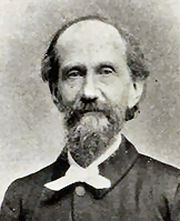
The towering figure of the second half of the 19th century – into the early part of the 20th century — was obviously Dr Andrew Murray.
Murray has been closely linked to the Cape revival in 1860. From his own congregation in Worcester, 50 young men offered themselves for the ministry of the word. Previously it was almost impossible to candidates. That revival was a watershed in Murray’s ministry. He understood that the Spirit, just like the wind, blows where it wills — John 3:8.
We cannot engineer revival, nor can we manipulate the Spirit. The lessons that Murray learned from this experience permeated all of his subsequent teachings and writings in books.
The key to the missionary problem
Precursors of 20th century spiritual warfare started in South Africa when Murray brought the issue into focus through his emphasis on prayer and the interest he aroused in the work of the Holy Spirit. Revivals in different parts of Africa were initiated from Cape Town after Murray’s founding of the South African General Mission (SAGM)[2] in 1889.
Murray and Spencer Walton organised conferences at Wellington, which became known as the South African version of Keswick. Murray would play a role in the beginnings of the Apostolic Faith Mission Church, led from 1914 to 1943 by Petrus le Roux, his missionary protégé.
Murray ministered from 1864 not only at the Groote Kerk, but also in the fisherman area of Roggebaai near to modern-day Bo-Kaap and in District Six.
He put in practice what he had taught about waiting on the Lord when he was invited to be a speaker at the World Missions Conference in New York, 1900 — billed as the biggest ever to be held. (At this time the effect of the Enlightenment and Rationalism had significantly diminished belief in unseen forces like the Holy Spirit in the West.)
Murray had no inner peace about going to New York, not even after the organisers tried to use his famous friend Dwight Moody to entice him. Murray felt morally-bound to stay with his people because of the Anglo-Boer War (1899-1902). We may safely surmise that he was sensitive to the Holy Spirit, only wanting to take instructions from the Lord.
Murray’s subsequent absence at the conference ironically became the biggest cause of missions at the start of the 20th century. After he received the papers and discussions at the conference, he wrote down what he thought was lacking at the event in a booklet The Key to the Missionary Problem. This booklet would have an explosive influence on the churches in Europe, America and South Africa. There Murray referred prominently to the 24-hour prayer watch of the Moravians. His booklet The Key to the Missionary Problem really set the scene for great things, also in Africa.
Women in spiritual renewal at the Cape
A rare feature of the late 18th century and early 20th century is that women spearheaded missionary work in South Africa for which men had no vision. Women had been playing a major role in spiritual renewal at the Cape, all-too-often behind the scenes.
A Cape-based missionary agency actually owes its existence to a woman. Mrs Martha Osborne was thoroughly impacted by the Holy Spirit after her conversion during a meeting of DL Moody. Her husband became seriously ill soon after his retirement, and eventually died. A newspaper report about the presence of “dens of the lowest description” among British soldiers in Cape Town gripped her. This became Martha Osborne’s call to missions. She sailed in 1879 to devote herself to work among the Cape soldiers.
In South Africa Martha Osborne initiated evangelistic missionary work in Cape Town, Natal and Zululand. She founded a Sailors’ Home, a Ladies Christian Workers Union, the Railway Mission and the South African YWCA.
The Africa Evangelistic Band (AEB) came into being through the evangelistic activity of Emma and Helena Garratt, two sisters. The Pilgrims, as their workers were called, evangelised in same-sex pairs, discipling new believers as they crisscrossed the country, bringing life to many a spiritually dead church.
Next week we will look briefly to his international contribution via the Holiness Movement. We will also see how the economic unit Bo-Kaap/District Six became the residential ancestors of Mitchell’s Plain and Khayelitsha where It’s Time Cape Town will take place on March 24. We will also highlight why Bo-Kaap/District Six can be regarded as the spiritual cradle of the new South Africa and how the opposition to apartheid started there. We will also see how the UDF founding in 1983 in Mitchell’s Plain was a false unity, misleading many people to come into demonic religious spiritual bondage.


